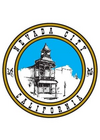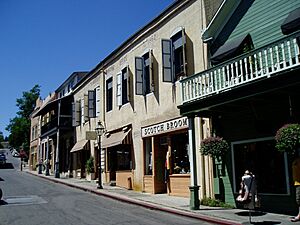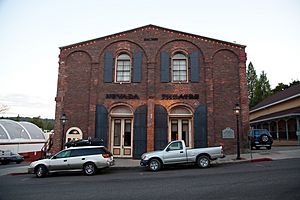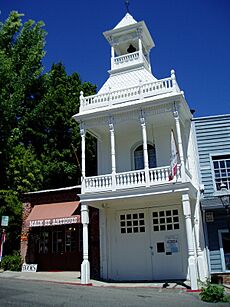Nevada City, California facts for kids
Quick facts for kids
Nevada City
|
||
|---|---|---|

Broad Street, Nevada City Downtown Historic District, in 2020
|
||
|
||
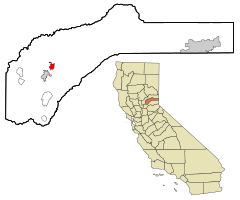
Location in Nevada County and the state of California
|
||
| Country | United States | |
| State | California | |
| County | Nevada | |
| Incorporated | April 19, 1856 | |
| Government | ||
| • Type | Council-Manager | |
| Area | ||
| • Total | 2.19 sq mi (5.67 km2) | |
| • Land | 2.19 sq mi (5.66 km2) | |
| • Water | 0.00 sq mi (0.01 km2) 0.17% | |
| Elevation | 2,477 ft (755 m) | |
| Population
(2020)
|
||
| • Total | 3,152 | |
| • Density | 1,439/sq mi (555.9/km2) | |
| Time zone | UTC-8 (Pacific (PST)) | |
| • Summer (DST) | UTC-7 (PDT) | |
| ZIP code |
95959
|
|
| Area code(s) | 530 | |
| FIPS code | 06-50874 | |
| GNIS feature IDs | 1659211, 2411225 | |
Nevada City is a cool town in California, United States. It's the main city, or county seat, of Nevada County, California. The town is about 60 miles (97 km) northeast of Sacramento. It is also about 84 miles (135 km) southwest of Reno. About 3,152 people lived here in 2020.
Contents
History of Nevada City
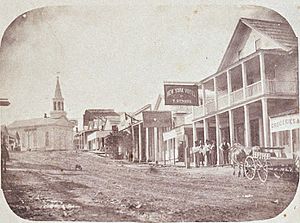
Long ago, the area was a Nisenan village called Ustumah.
In 1849, during the California Gold Rush, people from Europe first settled here. They named it Nevada, which means "snow-covered" in Spanish. This name came from the snowy mountains nearby.
The town was also called Deer Creek Dry Diggins and Caldwell's Upper Store. The first mine, called the Gold Tunnel, was built in 1850. A sawmill was also built in 1850 to cut wood.
In 1850 and 1851, Nevada City was a very important mining town. It was the top gold-mining area in California. The first newspaper, The Nevada Journal, started here in 1851. The Pioneer Cemetery was also founded around 1851.
Nevada City officially became a town on April 19, 1856. In 1864, "City" was added to its name. This was to avoid confusion with the nearby state of Nevada.
Geography and Climate
Nevada City covers about 2.2 square miles (5.7 km2). Most of this area is land. Only a tiny part is water.
The town of Nevada, Missouri is named after Nevada City.
The soil in Nevada City is mostly brown sandy loam. This soil comes from granite rock.
Nevada City's Climate
Nevada City gets a lot of rain, about 59 inches (1.5 meters) each year. This is because it's on the western side of the Sierra Nevada mountains. The climate is like the Mediterranean, with warm, dry summers and mild, wet winters.
It rarely snows much in the city itself. But it snows a lot in the mountains nearby.
Usually, there are about 31 days each year when the temperature reaches 90°F (32°C) or higher. There are also about 75 nights when it freezes. The highest temperature ever recorded was 111°F (44°C) in 1933. The lowest was -1°F (-18°C) in 1937 and 1972.
People of Nevada City (Demographics)
| Historical population | |||
|---|---|---|---|
| Census | Pop. | %± | |
| 1880 | 4,022 | — | |
| 1890 | 2,524 | −37.2% | |
| 1900 | 3,250 | 28.8% | |
| 1910 | 2,689 | −17.3% | |
| 1920 | 1,782 | −33.7% | |
| 1930 | 1,701 | −4.5% | |
| 1940 | 2,445 | 43.7% | |
| 1950 | 2,505 | 2.5% | |
| 1960 | 2,353 | −6.1% | |
| 1970 | 2,314 | −1.7% | |
| 1980 | 2,431 | 5.1% | |
| 1990 | 2,855 | 17.4% | |
| 2000 | 3,001 | 5.1% | |
| 2010 | 3,068 | 2.2% | |
| 2020 | 3,152 | 2.7% | |
| 2023 (est.) | 3,224 | 5.1% | |
| U.S. Decennial Census | |||
Population in 2020
The 2020 U.S. Census counted 3,152 people in Nevada City. Most people, about 85.2%, were White. About 8.4% of people were from two or more races. About 8.5% of the population was Hispanic or Latino.
There were 1,373 homes in Nevada City. About 14.4% of the people living in Nevada City were under 18 years old.
Population in 2010
In 2010, Nevada City had 3,068 people. Most of them, 92.5%, were White. About 6.7% of the people were Hispanic or Latino.
Most people lived in regular homes. Only a small number lived in group homes or institutions.
The population included people of all ages. About 16.9% were under 18. About 18.2% were 65 or older. The average age was 47.5 years.
Economy and Tourism
Nevada City's economy includes tourism. Many people visit the town.
Fun Tourist Spots
- Nevada City Winery was the first winery to open in Nevada County after Prohibition.
Arts and Culture
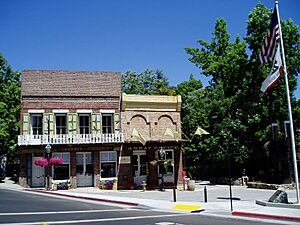
You can enjoy live music, theater, and dance at places like Miners Foundry Cultural Center and the Nevada Theatre.
Museums to Visit
- Firehouse No. 1 Museum
- Nevada County Narrow Gauge Railroad & Transportation Museum
- The Miners Foundry Cultural Center also has a small museum.
Yearly Events and Festivals
Nevada City has many fun events throughout the year:
- Mardi Gras
- Fourth of July Parade
- Teddy Bear Convention
- Psychic Faire
- Constitution Day Parade: This parade started in 1967. It's one of the oldest and biggest Constitution Day celebrations in the western United States.
- Wild and Scenic Film Festival: Started in 2003, this festival shows movies about nature, outdoor adventures, and extreme sports.
- Nevada City Film Festival: This festival began in 2001.
- Nevada City Storytelling Festival: Started in 1985.
- Summer Nights: An outdoor street festival with art and music.
- Victorian Christmas street fair.
- Nevada City Classic: A professional bike race that started in 1960.
Historic Buildings
The Nevada City Downtown Historic District has many important buildings. Some are listed on the National Register of Historic Places. Others are California Historical Landmarks.
Education in Nevada City
Nevada City has its own school district. It includes three schools:
- Deer Creek (Kindergarten to 4th grade)
- Seven Hills (5th to 8th grade)
- Nevada City Charter School (Kindergarten to 8th grade)
Other schools in the area are Nevada City School of the Arts, Yuba River Charter School, and Forest Charter School.
After 8th grade, most students go to Nevada Union High School. This high school is in nearby Grass Valley. Other high schools in the area include Silver Springs High School and Ghidotti High School.
Higher Learning
For older students, there are also schools like the California College of Ayurveda and Connected Communities Academy.
Famous People from Nevada City
- Lexie Alford (born 1998), youngest person to travel to every country
- Tina Basich (born 1969), professional snowboarder
- Donald J. Butz, U.S. Air Force (born 1933), Major General
- Jennie Carter (1830–1881) African-American journalist and essayist
- Anthony Chabot (1813–1888), businessman; helped invent hydraulic mining in Nevada City
- Peter Collier (1939–2019), political author
- Joseph Cornell (born 1950), naturalist and author
- Alela Diane (born 1983), singer/songwriter
- Matt DiBenedetto (born 1991), NASCAR driver
- Heather Donahue, actress and writer
- Eleanor Dumont (1829–1879), professional gambler
- Alasdair Fraser (born 1955), Scottish fiddler
- Noah Georgeson (born 1975), musician, producer
- Felix Gillet (1835–1908), pioneer California plant expert
- Oakley Hall (1920–2008), novelist
- Robert M. Hunt (1828–1902), physician
- Roger Hodgson (born 1950), singer/songwriter and ex-Supertramp member
- Swami Kriyananda (1926–2013), spiritual teacher
- Cliff Kushler, inventor
- Charles Marsh, possibly Nevada City's first resident
- Tully Marshall (1864–1943), actor
- Jim McClarin (born 1945/1946), politician
- John McEntire (born 1970), drummer, recording engineer, and music producer
- Thomas Bard McFarland (1828–1908), judge
- Stephen McNallen (born 1948), Germanic Neopagan leader and writer
- Joanna Newsom (born 1982), harpist, singer/songwriter, and actress
- Tim O'Connor (1927–2018), actor
- John Olmsted (1938–2011), naturalist
- Utah Phillips (1935–2008), folk singer, activist
- Ed Reimers (1912–2009), actor and television announcer
- Terry Riley (born 1935), composer
- Gyan Riley (born 1977), guitarist and composer
- Alexander Rossi (born 1991), professional race car driver, won the 100th Indianapolis 500-Mile Race in 2016
- Julia Ann Rudolph (c. 1820 – c. 1900), photographer
- Aaron A. Sargent (1827–1887), U.S. Senator
- Lorenzo Sawyer (1820–1891), Chief Justice of the California Supreme Court
- Niles Searls (1825–1907), Chief Justice of the Supreme Court of California
- Claus Sievert (1949–2009), printmaker, illustrator
- Mariee Sioux (born 1985), singer/songwriter
- Gary Snyder (born 1930), poet
- Rosie Stephenson-Goodknight (born 1953), editor
- Evan Strong (born 1986), professional snowboarder
- Heinrich Sylvester Theodor Tiling (1818–1871), physician and botanist
Sister Cities
Nevada City is connected with two towns in Cornwall, UK. These are Penzance and St Just in Penwith. This connection happened because many Cornish miners came to California during the gold rush. They shared their mining skills in the area.
Nevada City Hall has a special room for this connection. It holds items from Cornwall that were given during visits.
See also
 In Spanish: Nevada City para niños
In Spanish: Nevada City para niños


